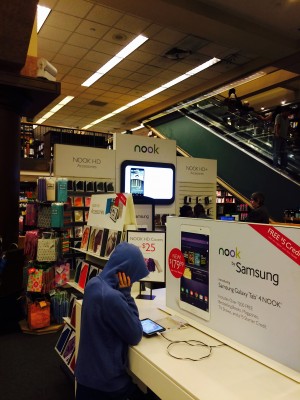Counterpoint: Electronic Over Print
Barnes & Noble shoppers contemplate whether to buy their books in print or to invest in an e-reader. (Lauren Macdonald/The Observer)
October 22, 2014
I’ve bought my last college textbook. After three years of running around, trying to find good deals on college books, I’ve had enough.
College books are bulky, absurdly overpriced and sometimes rarely used in class. Every college student knows that and has grudgingly come to terms with it. We are forced to suppress our sobs when we watch the balances of our bank accounts and our cash dwindle right before our eyes for the sake of higher learning. But e-readers and tablets can offer the perfect alternative. They are certainly more practical in college.

Most people usually criticize e-readers and tablets because they are believed to disconnect readers from the books due to the loss of physicality, texture of books and sentimental value. Some also believe there is a level of distraction that comes with e-readers. Not many people are willing to let go of print. An article published earlier this year “Paper vs. Digital Reading is an Exhausted Debate” in The Guardian called digital books “painfully ugly.”
Aesthetics, however, are not going to pay for the piles of college loans or outweigh the benefits of buying cheaper digital editions. They also won’t alleviate the pain in our hands and backs from carrying around books. With college tuition increasing every year, many students find that it’s important to be adaptable and open up to other platforms for reading, even if we won’t get pretty book covers or illustrations in return. That’s what our imaginations are for.
E-readers are much cheaper than print books. A book I had to buy last semester cost $16 in print and $9 in the Kindle store. Not to mention, I could have bought a $79 refurbished Kindle Fire HD tablet with the five print books I bought for just this semester alone, a $250 Samsung Galaxy Tab for the nearly 30 books I bought this year and another $500 iPad with the dozens of books I bought in the three years I’ve been at Fordham so far.
One misconception about e-books is that they cannot be rented. On the contrary, services like Amazon and Chegg definitely have rental options for e-books and e-textbooks. There are also several databases and digital libraries like Scribd, Project Gutenberg and Oyster Books, that provide books for free or for a cheap monthly subscription. It’s a golden opportunity, especially for an English major like myself who has had to read several classics for classes that were available free of charge.
Sure, print books are traditional and good, but they also yellow with age and can tear easily. The ink on the pages fades in time. But the only things fading on an e-book are annotations and highlights because they can either be deleted or modified. Students need to stop dismissing e-readers and tablets without realizing their full potential. Print books arguably allow readers to focus because the Internet and different applications aren’t at the tips of our fingers—literally. But it’s these very applications that allow us to have deeper and more interactive readings.
Besides books, e-readers and tablets are very convenient way to read PDF files for class. We don’t need to print out pages upon pages of dispensable readings when we could simply open the reading up on our tablet and highlight and annotate to our hearts’ content. All I have to do is click on the Blackboard application on my iPad and start downloading the readings from my class. I have more than 20 PDF files on my iPad, and I can constantly switch from one to another and work on different ones without stuffing my notebook with 50 pages’ worth of readings.
It’s also convenient for writing papers. There are ways to search for keywords especially if you’re looking for a passage so you don’t have to flip through every single page. They’re much more conducive to learning because they offer an immediately gratifying way of reading and taking notes on books. We don’t need to have a million post-its sticking out of our books, fearing that they may rip or detach themselves from the books. My tablet allows me to bookmark pages that I think are important and allows me to highlight, underline and strikeout passages and sentences with the single swipe of my index finger.
Sure, it’s fun being able to read a book endlessly without checking to see if the battery is dying.
But tablets make it easier for us to read whatever we want, whenever we want and however we want. Students don’t have to buy editions with larger font if the font size of the words are too small; they could simply resize it. If they hate that the words in a book is in Times New Roman, they have six to 10 different options to choose from. If there’s a sudden blackout, they could just brighten their screens and continue reading in their own bubbles while the rest of the literary world is in a state of panic.
And while the crinkles and smudges on print books tell a story about the person reading them, the scratches on the screen and the tattered case of an e-reader or tablet are just as permanent, and they can tell a story just as well.













